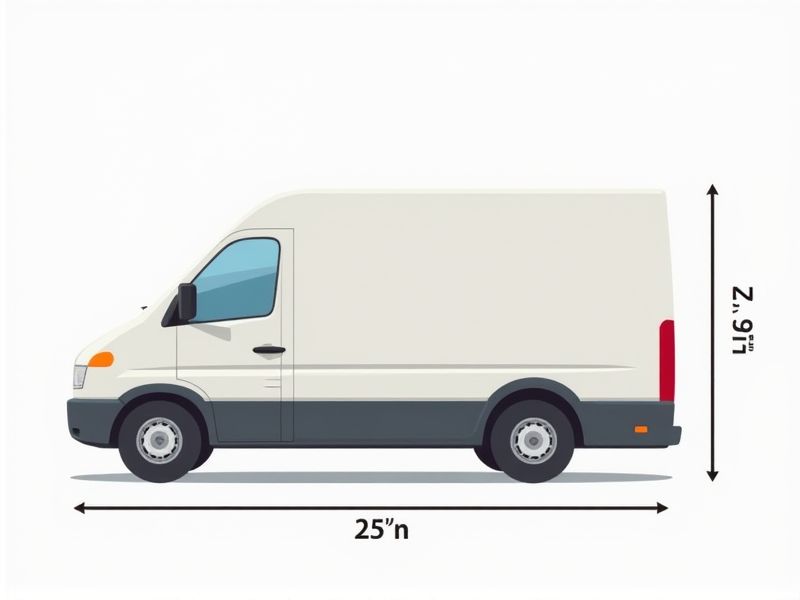
Cargo vans come in various sizes, but standard dimensions are commonly referenced to help with planning and logistics. For example, a typical full-size cargo van, such as the Ford Transit, offers interior cargo space that is approximately 10-12 feet long, 5.5-6 feet wide, and 4.5-6.5 feet high, depending on the model and roof height. Make sure to check the specific make and model for exact measurements, as features like extended lengths or high roofs can add additional cargo space. Knowing these dimensions ensures you can choose the right van for your hauling, delivery, or business needs.
Interior Cargo Length
The standard interior cargo length of a typical cargo van ranges from 9 to 12 feet, providing ample space for transporting goods. This measurement is critical for businesses that require efficient delivery of large items, allowing for the accommodation of pallets and bulk materials. Most models feature a cargo height of around 5 to 6 feet, enabling you to stack items securely without compromising headroom. Understanding these dimensions can help you choose the right cargo van that best suits your logistics and operational needs.
Interior Cargo Width
The interior cargo width of a standard cargo van typically measures between 54 to 70 inches, providing ample space for transporting goods. This width allows for versatile loading options, accommodating pallets or larger items efficiently. Most cargo vans feature a flat load floor, ensuring easy access and maximizing usable space. When selecting a cargo van, consider the specific interior cargo width to meet your logistical needs effectively.
Interior Cargo Height
The standard interior cargo height of a cargo van typically ranges from 55 to 78 inches, depending on the model and manufacturer. This measurement is crucial for accommodating various types of loads, with a higher cargo height allowing for taller items or shelving installations. For example, a van with a 75-inch clearance can easily fit most palletized goods, making it ideal for logistics operations. You should consider this height when selecting a cargo van to ensure it meets your specific transport needs.
Wheelbase Length
Cargo vans commonly emphasize wheelbase length for enhanced stability and load capacity. A typical wheelbase for many models ranges from 118 inches to 170 inches, impacting how vehicles handle varied cargo sizes. For instance, a longer wheelbase often correlates with a better ride quality, accommodating up to 4,000 pounds of cargo weight. When selecting your cargo van, consider how the wheelbase aligns with your transportation needs for optimal performance.
Exterior Height
The standard exterior height of most cargo vans typically ranges between 6 to 7 feet, which allows for easy loading and unloading of goods. This height is essential for accessing standard loading docks and ensuring compatibility with common garage clearances. A cargo van with a height of 6.5 feet provides ample vertical space for bulkier items while maintaining maneuverability in urban environments. When choosing your cargo van, consider the height specifications to optimize both your operational efficiency and driver comfort.
Exterior Width
The standard exterior width of a cargo van typically ranges between 79 to 85 inches, accommodating various cargo sizes while ensuring maneuverability. For example, models like the Ford Transit and Chevrolet Express offer widths of approximately 80 inches and 84 inches, respectively. This dimension not only aids in maximizing cargo space but also enhances stability during transit. When selecting a cargo van, consider how this exterior width might affect your driving experience and parking in urban environments.
Load Capacity
The standard load capacity of a cargo van typically ranges from 3,000 to 4,000 pounds, depending on the vehicle model and configuration. These vans often feature a cargo volume from 250 to 400 cubic feet, allowing for the transportation of various goods and equipment. Your choice of cargo van should align with the specific load requirements of your business, ensuring efficient logistics and minimizing the risk of overloading. Many cargo vans also come equipped with reinforced cargo floors and secure tie-down points, enhancing safety during transit.
Maximum Payload
The maximum payload capacity for cargo vans typically ranges from 2,000 to 4,000 pounds, depending on the model and configuration. For instance, the Ford Transit 250 can carry up to 3,800 pounds, making it ideal for heavy-duty transportation of goods. Mercedes-Benz Sprinter vans also offer impressive payload capacities, often exceeding 3,500 pounds, providing versatility for various commercial needs. When selecting a cargo van, consider both the payload and the interior space, which can vary from 250 to over 500 cubic feet, ensuring you choose the right vehicle for your logistical requirements.
Rear Door Opening Dimensions
Cargo vans typically feature rear door openings that vary in size depending on the model. For instance, many commercial cargo vans offer an opening height of approximately 50 to 60 inches and a width ranging from 48 to 60 inches, facilitating easy access for loading and unloading. The dimensions of these openings are crucial for accommodating standard pallets which often measure 48 by 40 inches. Understanding these measurements can significantly enhance your operational efficiency when selecting the right cargo van for your transportation needs.
Side Door Opening Dimensions
The side door opening dimensions of standard cargo vans typically range from 48 to 60 inches in width and 52 to 70 inches in height, providing easy accessibility for loading and unloading. This generous space is crucial for accommodating various cargo types, including palletized goods, tools, and equipment. Many models also feature a low floor height, which can be around 22 to 30 inches, facilitating the movement of heavier items without the need for excessive lifting. Understanding these dimensions helps ensure you select a van that meets your specific transport needs efficiently.
